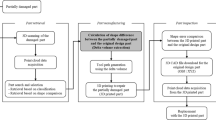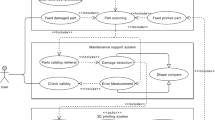Abstract
Three-dimensional (3D) printing technology is an excellent tool for implementing multi item, small scale production or for manufacturing objects of complex shape, and has been utilized in many areas of daily life. One typical application is parts maintenance. For a partially damaged part to be repaired using a 3D printer, it is essential to generate a delta volume for the damaged area. A typical method of delta volume generation is to create a mesh using Delaunay triangulation or Poisson surface reconstruction from the point cloud of a laser scan of the damaged part and to perform a boolean subtraction operation with the mesh of the original part. However, when generating the delta volume, this method is prone to error due to noise, non-uniform sampling, and missing data in the point cloud. To address this problem, we propose a mesh offset based method capable of robust delta volume generation despite point cloud noise. This method consists of four steps: preprocessing, point cloud extraction, mesh extraction, and delta volume extraction. To experimentally validate the proposed method, a prototype system was developed and a numerical implementation was performed for a partially damaged ball valve.
Similar content being viewed by others
Abbreviations
- P d :
-
Point cloud of the partially damaged part
- M o :
-
Original mesh model
- DV damaged :
-
Delta volume of the partially damaged area
- P d’ :
-
Point cloud with outliers removed
- P sampling :
-
Sampled points from original mesh
- P registered :
-
Registered point cloud
- P segmented :
-
Point cloud of the partially damaged area
- M segmented :
-
Mesh of the partially damaged area
- M offset :
-
Offset mesh
References
J. H. Shim, W. S. Yun and T. J. Ko, Successful examples of 3D printing technology-based start-up enterprises, Journal of the Korean Society of Manufacturing Process Engineers, 15(2) (2016) 104–110.
S. Ford and M. Despeisse, Additive manufacturing and sustainability: an exploratory study of the advantages and challenges, Journal of Cleaner Production, 137 (2016) 1573–1587.
T. Rayna and L. Striukova, From rapid prototyping to home fabrication: how 3D printing is changing business model innovation, Technological Forecasting and Social Change, 102 (2016) 214–224.
H. Kim, M. Cha, B. C. Kim, T. Kim and D. Mun, Part library-based information retrieval and inspection framework to support part maintenance using 3D printing technology, Rapid Prototyping Journal, 25(3) (2019) 630–644.
InssTek, Repairing Jet Engine Part and Extending Life Cycle for Korean Air Force, http://www.insstek.com/content/customer_success/cs_4, InssTek, Inc., Daejeon (2019).
M. Berger, A. Tagliasacchi, L. M. Seversky, P. Alliez, G. Guennebaud, J. A. Levine and C. T. Silva, A survey of surface reconstruction from point clouds, Computer Graphics Forum, 36(1) (2017) 301–329.
M. B. Bauza, S. P. Moylan, R. M. Panas, S. C. Burke, H. E. Martz, J. S. Taylor, P. Alexander, R. H. Knebel, R. Bhogaraju, M. T. O’Connell and J. D. Smokovitz, Study of accuracy of parts produced using additive manufacturing, Proc. of the 2014 Spring Topical Meeting, 57 (2014) 86–91.
M. Salmi, K. S. Paloheimo, J. Tuomi, J. Wolff and A. Mäkitie, Accuracy of medical models made by additive manufacturing (rapid manufacturing), Journal of Cranio-Maxillofacial Surgery, 41(7) (2013) 603–609.
S. Mahmood, A. J. Qureshi and D. Talamona, Taguchi based process optimization for dimension and tolerance control for fused deposition modelling, Additive Manufacturing, 21 (2018) 183–190.
R. Anitha, S. Arunachalam and P. Radhakrishnan, Critical parameters influencing the quality of prototypes in fused deposition modelling, Journal of Materials Processing Technology, 118(1-3) (2001) 385–388.
M. Martorelli, S. Gerbino, M. Giudice and P. Ausiello, A comparison between customized clear and removable orthodontic appliances manufactured using RP and CNC techniques, Dental Materials, 29(2) (2013) e1–e10.
ASTM F2792-12a, Standard Terminology for Additive Manufacturing Technologies, ASTM International, West Conshohocken, PA (2012).
J. A. Gonzalez, J. Mireles, Y. Lin and R. B. Wicker, Characterization of ceramic components fabricated using binder jetting additive manufacturing technology, Ceramics International, 42(9) (2016) 10559–10564.
Z. Chen, Z. Li, J. Li, C. Liu, C. Liu, Y. Li and F. Yuelong, 3D printing of ceramics: a review, Journal of the European Ceramic Society, 39(4) (2019) 661–687.
I. Gibson, D. Rosen and B. Stucker, Binder jetting, Additive Manufacturing Technologies, Springer, New York, NY (2015) 205–218.
M. Zenou and L. Grainger, Additive manufacturing of metallic materials, Additive Manufacturing, Butterworth-Heinemann (2018) 53–103.
H. Miyanaji, S. Zhang, A. Lassell, A. Zandinejad and L. Yang, Process development of porcelain ceramic material with binder jetting process for dental applications, JOM, 68(3) (2016) 831–841.
J. Deckers, J. Vleugels and J. P. Kruth, Additive manufacturing of ceramics: a review, Journal of Ceramic Science and Technology, 5(4) (2014) 245–260.
M. E. Kenney, Cost reduction through the use of additive manufacturing (3D printing) and collaborative product lifecycle management technologies to enhance the Navy’s maintenance programs, Master’s Thesis, Naval Postgraduate School, Monterey, United States (2013).
K. C. Antony and G. W. Goward, Aircraft gas turbine blade and vane repair, Superalloys, 745 (1988) 44827638.
J. Huang and C. H. Menq, Automatic CAD model reconstruction from multiple point clouds for reverse engineering, Journal of Computing and Information Science in Engineering, 2(3) (2002) 160–170.
G. Barill, N. G. Dickson, R. Schmidt, D. I. Levin and A. Jacobson, Fast winding numbers for soups and clouds, ACM Transactions on Graphics (TOG), 37(4) (2018) 43.
J. C. Carr et al., Surface interpolation with radial basis functions for medical imaging, IEEE Transactions on Medical Imaging, 16(1) (1997) 96–107.
J. C. Carr et al., Reconstruction and representation of 3D objects with radial basis functions, ACM SIGGRAPH 01 (2001) 67–76.
D. T. Lee and B. J. Schachter, Two algorithms for constructing a Delaunay triangulation, International Journal of Computer and Information Sciences, 9(3) (1980) 219–242.
M. Kazhdan, M. Bolitho and H. Hoppe, Poisson surface reconstruction, Proceedings of the Fourth Eurographics Symposium on Geometry Processing, 7 (2006).
S. H. Lee, H. C. Kim, S. M. Hur and D. Y. Yang, STL file generation from measured point data by segmentation and Delaunay triangulation, Computer-Aided Design, 34(10) (2002) 691–704.
S. Lee, C. I. Park and C. M. Park, An improved parallel algorithm for Delaunay triangulation on distributed memory parallel computers, Parallel Processing Letters, 11(02n03) (2001) 341–352.
D. Zhou, Y. Xu, Q. Zhang and X. Wei, A new triangulation algorithm from 3D unorganized dense point cloud, TENCON 2015-2015 IEEE Region 10 Conference, IEEE (2015) 1–6.
M. Kazhdan and H. Hoppe, Screened poisson surface reconstruction, ACM Transactions on Graphics (ToG), 32(3) (2013) 29.
C. Piya, J. M. Wilson, S. Murugappan, Y. Shin and K. Ramani, Virtual repair: geometric reconstruction for remanufacturing gas turbine blades, Proc. of the 2011 International Design Engineering Technical Conferences and Computers and Information in Engineering Conference (2011) DETC2011-48652.
M. S. Tootooni, A. Dsouza, R. Donovan, P. K. Rao, Z. J. Kong and P. Borgesen, Classifying the dimensional variation in additive manufactured parts from laser-scanned three-dimensional point cloud data using machine learning approaches, Journal of Manufacturing Science and Engineering, 139(9) (2017) 091005.
M. Khanzadeh, P. Rao, R. Jafari-Marandi, B. K. Smith, M. A. Tschopp and L. Bian, Quantifying geometric accuracy with unsupervised machine learning: using self-organizing map on fused filament fabrication additive manufacturing parts, Journal of Manufacturing Science and Engineering, 140(3) (2018) 031011.
H. Kim, M. Cha, B. C. Kim, I. Lee and D. Mun, Maintenance framework for repairing partially damaged parts using 3D printing, International Journal of Precision Engineering and Manufacturing (2019) 1–14.
S. W. Sloan, A fast algorithm for generating constrained Delaunay triangulations, Computers and Structures, 47(3) (1993) 441–450.
W. Garage, PCL, The Point Cloud Library, https://pointclouds.org/ (2019).
P. J. Besl and N. D. McKay, Method for registration of 3-D shapes, Sensor Fusion IV: Control Paradigms and Data Structures, International Society for Optics and Photonics, 1611 (1992) 586–606.
Geometric Tools, https://www.geometrictools.com/ (2019).
K. Y. Kwon, Design point generation method from a lightweight model for dimensional quality management in shipbuilding, Journal of Ship Production and Design, 35(4) (2019) 353–363.
Kitware, The Visual Toolkit (VTK), https://vtk.org/, Kitware, Inc., Clifton Park (2019).
Spatial, 3D ACIS Modeler, https://www.spatial.com/products/3d-acis-modeling, Spatial Corporation, Broomfield (2019).
Tech Soft 3D, HOOPS Visualize, https://www.techsoft3d.com/products/hoops/visualize/, Tech Soft 3D, Inc., Bend (2019).
Acknowledgments
This research was supported by the Industrial Core Technology Development Program (Project ID: 20009324) funded by the Korea government (MOTIE), by the AI-based Gasoil Plant O&M Core Technology Development Program (Project ID: 21ATOG-C161932-01) funded by the Korea government (MOLIT), and by the Basic Science Research Program (Project ID: NRF-2019R1F1A1053542) through the National Research Foundation of Korea (NRF) funded by the Korea government (MSIT).
Author information
Authors and Affiliations
Corresponding author
Additional information
Youngki Kim is a Post Doctor of the Korea Institute of Machinery and Materials, Daejeon, South Korea. He received his Ph.D. in Mechanical Engineering from Korea Advanced Institute of Science and Technology. His research interests are in CAD data translation, 3D CAD model reconstruction and 3D printing.
Ki-Youn Kwon is an Assistant Professor at the School of Industrial Engineering, the Kumoh National Institute of Technology. He has received his Ph.D. from KAIST, and a M.S. and B.S. from Korea University. His research interests are computer-aided design, computer-aided manufacturing, mesh generation, digital collaboration, cad model exchange, dimensional quality management. His application domains are all industries related to mechanical engineering such as automobile, shipbuilding and plant.
Duhwan Mun is a Professor at the School of Mechanical Engineering at Korea University. He received a B.S. in Mechanical Engineering from Korea University; an M.S. and Ph.D. in Mechanical Engineering from KAIST. His research interests include CAD, industrial data standards, PLM, knowledge-based engineering, virtual reality for engineering applications, and 3D printing.
Rights and permissions
About this article
Cite this article
Kim, Y., Kwon, K. & Mun, D. Mesh-offset-based method to generate a delta volume to support the maintenance of partially damaged parts through 3D printing. J Mech Sci Technol 35, 3131–3143 (2021). https://doi.org/10.1007/s12206-021-0635-8
Received:
Revised:
Accepted:
Published:
Issue Date:
DOI: https://doi.org/10.1007/s12206-021-0635-8




